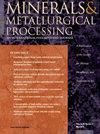矿物加工和冶炼中的单宁
Q2 Materials Science
引用次数: 40
摘要
本研究提供了最新的审查单宁,特别是在矿物加工和冶金过程中的单宁。在许多浮选应用中,Quebracho是一种非常有用的试剂,可作为抑制剂和分散剂。本研究中提到了三种不同类型的魁布拉丘;“S”或“图帕索尔ATO”,“O”或“图帕芬ATO”,以及“A”或“席尔瓦弗奇”。应该指出的是,文学作品经常简单地提到“魁布拉契”,而不区分具体的类型。Quebracho最常用于工业中,作为分离萤石和方解石的方法,传统上这是相当具有挑战性的,因为这两种矿物具有共同的离子钙。以方解石矿物为主要脉石源的黄铁矿在浮选中的应用还包括重晶石和白钨矿。在硫化物体系中,quebracho是铜、铅、锌络合物差动浮选的关键药剂。本文还详细介绍了硼砂在锌矿石中锗的沉淀和超细金的回收中的应用。该分析探讨了克布拉契在采掘冶金领域的广泛用途和方法,并扩展了Iskra和Kitchener在帝国理工学院之前题为“矿物加工中的克布拉契”的研究。本文章由计算机程序翻译,如有差异,请以英文原文为准。
Tannins in mineral processing and extractive metallurgy
This study provides an up to date review of tannins, specifically quebracho, in mineral processing and metallurgical processes. Quebracho is a highly useful reagent in many flotation applications, acting as both a depressant and a dispersant. Three different types of quebracho are mentioned in this study; quebracho “S” or Tupasol ATO, quebracho “O” or Tupafin ATO, and quebracho “A” or Silvafloc. It should be noted that literature often refers simply to “quebracho” without distinguishing a specific type. Quebracho is most commonly used in industry as a method to separate fluorite from calcite, which is traditionally quite challenging as both minerals share a common ion—calcium. Other applications for quebracho in flotation with calcite minerals as the main gangue source include barite and scheelite. In sulfide systems, quebracho is a key reagent in differential flotation of copper, lead, zinc circuits. The use of quebracho in the precipitation of germanium from zinc ores and for the recovery of ultrafine gold is also detailed in this work. This analysis explores the wide range of uses and methodology of quebracho in the extractive metallurgy field and expands on previous research by Iskra and Kitchener at Imperial College entitled, “Quebracho in Mineral Processing”.
求助全文
通过发布文献求助,成功后即可免费获取论文全文。
去求助
来源期刊

Minerals & Metallurgical Processing
工程技术-矿业与矿物加工
CiteScore
0.84
自引率
0.00%
发文量
0
审稿时长
>12 weeks
期刊介绍:
For over twenty-five years, M&MP has been your source for the newest thinking in the processing of minerals and metals. We cover the latest developments in a wide range of applicable disciplines, from metallurgy to computer science to environmental engineering. Our authors, experts from industry, academia and the government, present state-of-the-art research from around the globe.
 求助内容:
求助内容: 应助结果提醒方式:
应助结果提醒方式:


